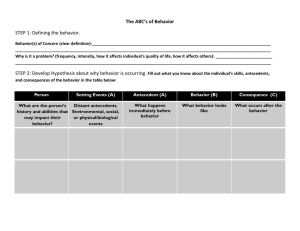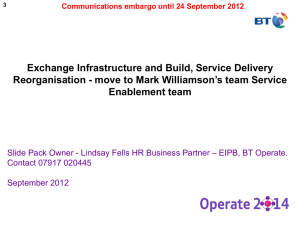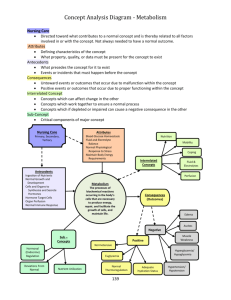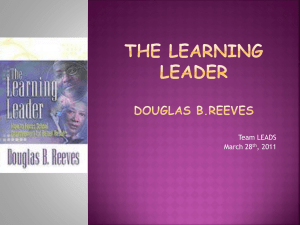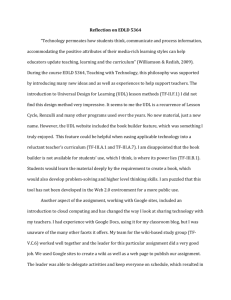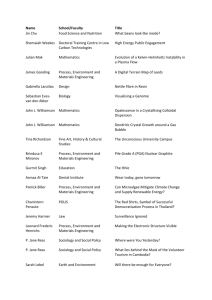Genuine, non-calculative trust with calculative antecedents
advertisement
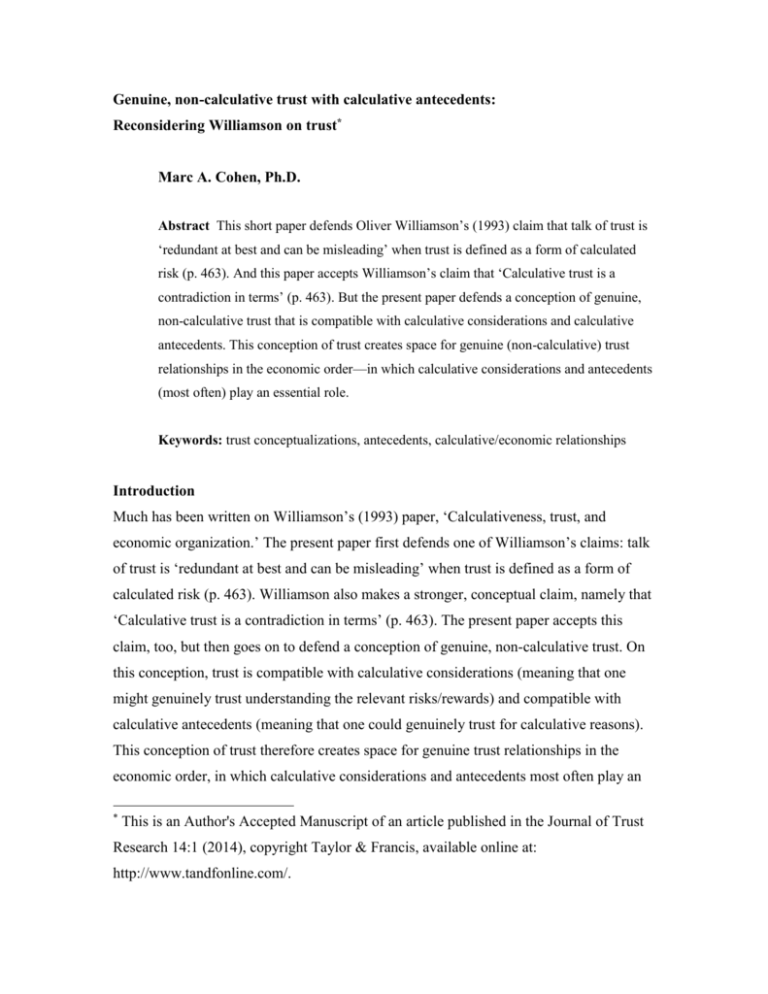
Genuine, non-calculative trust with calculative antecedents: Reconsidering Williamson on trust* Marc A. Cohen, Ph.D. Abstract This short paper defends Oliver Williamson’s (1993) claim that talk of trust is ‘redundant at best and can be misleading’ when trust is defined as a form of calculated risk (p. 463). And this paper accepts Williamson’s claim that ‘Calculative trust is a contradiction in terms’ (p. 463). But the present paper defends a conception of genuine, non-calculative trust that is compatible with calculative considerations and calculative antecedents. This conception of trust creates space for genuine (non-calculative) trust relationships in the economic order—in which calculative considerations and antecedents (most often) play an essential role. Keywords: trust conceptualizations, antecedents, calculative/economic relationships Introduction Much has been written on Williamson’s (1993) paper, ‘Calculativeness, trust, and economic organization.’ The present paper first defends one of Williamson’s claims: talk of trust is ‘redundant at best and can be misleading’ when trust is defined as a form of calculated risk (p. 463). Williamson also makes a stronger, conceptual claim, namely that ‘Calculative trust is a contradiction in terms’ (p. 463). The present paper accepts this claim, too, but then goes on to defend a conception of genuine, non-calculative trust. On this conception, trust is compatible with calculative considerations (meaning that one might genuinely trust understanding the relevant risks/rewards) and compatible with calculative antecedents (meaning that one could genuinely trust for calculative reasons). This conception of trust therefore creates space for genuine trust relationships in the economic order, in which calculative considerations and antecedents most often play an * This is an Author's Accepted Manuscript of an article published in the Journal of Trust Research 14:1 (2014), copyright Taylor & Francis, available online at: http://www.tandfonline.com/. Non-calculative trust, calculative antecedents 2 essential role. Williamson does not distinguish between trust itself being calculative and the antecedents being calculative. But by introducing this distinction, and separating the question of what it means to trust from the question of why one trusts in particular cases, we can identify four possibilities: 1: calculative antecedent, calculative trust 2: non-calculative antecedent, calculative trust 3: calculative antecedent, non-calculative trust, and 4: non-calculative antecedent, non-calculative trust When Williamson argues that talk of trust is both redundant and misleading (when trust is defined in calculative terms), he is taken to reject (1) above. The present paper shows that Williamson’s argument applies to (2) as well. This greatly expands the force of Williamson’s argument: the management literature overwhelmingly operates with calculative definitions of trust, and Williamson’s argument applies across that literature (regardless of whether the antecedents are calculative or not). Williamson also allows that there is genuine, non-calculative trust in personal relationships, (4) above. But this paper argues that we can have genuine, non-calculative trust with calculative antecedents—this is (3) above. As a result, we can make conceptual sense of trust in the economic context where calculative antecedents are at work and are considered appropriate. The argument offered here, that (3) makes conceptual sense and as a result we can genuinely trust on the basis of calculative antecedents, follows from the definition of genuine, noncalculative trust defended in what follows. Contra Reich-Graefe’s (2014) contribution to this special issue, there is no tautology here: trust is itself a non-calculative relationship, even if the antecedents are calculative, and even if the antecedents can never be—in practice—purely non-calculative. Two terminological notes before beginning: First, Williamson uses the terms ‘personal trust’ and ‘non-calculative trust’ interchangeably; I will refer to non-calculative trust as ‘trust’ or as ‘genuine trust,’ but I avoid the term ‘personal trust’ because we could have genuine trust relationships between organizations and between persons and organizations. My examples involve both individuals and firms. Second, Williamson defines ‘calculativeness’ as, ‘a situation in which the affected parties (1) are aware of the Non-calculative trust, calculative antecedents 3 range of possible outcomes and their associated probabilities, (2) take cost-effective actions to mitigate hazards and enhance benefits, (3) proceed with the transaction only if expected net gains can be projected, and, (4) if X can complete the transaction with any of several Ys, the transaction is assigned to that Y for which the largest net gain can be projected’ (p. 467). The present paper accepts Williamson’s definition. Williamson’s first claim: talk of trust is ‘redundant at best and can be misleading’ when trust is defined as a form of calculated risk (p. 463) To begin with, consider one of Williamson’s examples, a widely discussed one taken from Coleman (1990), originally in Wechsberg (1966): a ship owner had repairs made at an Amsterdam shipyard, he needed funds to pay for the repairs, and a merchant banker in London agreed to lend the money without a contract and without paper documentation. According to Coleman, ‘The case clearly involves trust. The manager of the Norwegian department at Hambros [the merchant bank] placed trust in the Norwegian shipowner who telephoned him—trust to the extent of £200,000 of Hambros’s money. There was no contract signed, no paper involved in the transaction, nothing more substantial than the shipowner’s intention to repay the money and the Hambros man’s belief in both the shipowner’s honesty and his ability to repay’ (1990, p. 92; quoted in Williamson, 1993, p. 464). At the same time, however, Coleman offers a purely economic account of why the merchant banker provided the funds: the banker— literally—made a bet on the basis of his knowledge of the shipping industry. Coleman: ‘If the chance of winning, relative to the chance of losing, is greater than the amount that would be lost (if he loses), relative to the amount that would be won (if he wins), then by placing the bet he [the trustor] has an expected gain; and if he is rational, he should place it. This simple expression is based on the postulate of maximization of utility under risk’ (1990, p. 99, Coleman’s emphasis). Williamson refines Coleman’s calculation of utility, but accepts the calculative account: the loan was made because the London bank ‘had the most knowledge of the shipowner and the best prospect for future business’ (Williamson, 1993, p. 470). Given the clear economic rationale, here Williamson argues that Coleman’s talk of trust is redundant: ‘calculativeness [economic reasoning] is determinative throughout and... Non-calculative trust, calculative antecedents 4 invoking trust merely muddies the waters’ (p. 471). So, for Williamson, there are two ways to explain why the banker lent money to the ship-owner (and in the process, took a risk): either the banker engaged in calculative (economic) reasoning, and he determined that the potential benefit justified the risks, or the banker trusted the ship-owner. Trust and calculation are competing explanations for the banker’s action. Given that the bank made a calculative/economic decision, Williamson argues that talk of trust adds nothing, and we can therefore dispense with talk of trust as redundant. Note two points about the argument in the previous paragraph. First, Williamson claims that ‘it is redundant at best and can be misleading to use the term “trust” to describe commercial exchange for which cost-effective safeguards have been devised in support of more efficient exchange’ (p. 463). The example and the argument do not support this claim, because there are no ‘safeguards’ here to ‘support more efficient exchange.’ Below I will argue that genuine trust is not compatible with contracts and other coercive mechanisms, what Williamson refers to as ‘safeguards,’ but that is not Williamson’s point here—the safeguards do not factor into Williamson’s argument. Second, the argument presents trust and calculative reasoning as competing explanations, and Williamson claims that one of the two explanations is redundant. But it is not clear why the explanations can’t be complementary. We will also return to this point below in my positive account of genuine trust, which is compatible with calculative reasoning. Here Williamson is better understood as follows. Coleman (1990) and also Gambetta (1988)—Williamson cites both in this context—are defining trust, they are offering an account of what it means to trust (or, put another way, an account of what we do when we trust). Coleman defines trust in terms of making a bet. And according to Gambetta trust is an assessment of probabilities: ‘trust... is a particular level of subjective probability with which an agent assesses that another agent or group of agents will perform a particular action.... When we say we trust someone or that someone is trustworthy, we implicitly mean that the probability that he will perform an action that is beneficial or at least not detrimental to us is high enough for us to consider engaging in some form of cooperation with him’ (Gambetta, 1988, p. 217, quoted in Williamson, 1993, p. 464). On both of these accounts, when A trusts B to do X, A holds positive expectations about B’s doing X, or A holds positive expectations about the outcome (the Non-calculative trust, calculative antecedents 5 risks are justified by the potential gain). So the term ‘trust’ is merely a label for a set of calculative considerations, meaning that trust is itself a calculative relationship. As Williamson notes, this is true across the social science literature, in which trust is defined ‘as a subclass of [situations] involving risk,’ in which the term trust refers to ‘situations in which the risk one takes depends on the performance of another actor,’ (p. 463; Williamson is quoting Gambetta, 1988). So talk of trust is redundant because it adds nothing to the calculative considerations that are already present. Put another way, when trust is defined in calculative terms trust is not even an alternative explanation. And talk of trust is misleading, because it could suggest that something other than calculative considerations are at work, given our intuitive way of understanding trust in noncalculative terms. Note, further, that on Coleman’s and Gambetta’s definitions, trust is a calculative relationship apart from the question of how/why the relevant expectations were formed— that is, apart from the antecedents of trust. Or, some think of trust as a kind of stance, ‘A trusts B’ means that A adopts a certain stance toward B—put into those terms trust is a calculative stance, again regardless of the kind of antecedent. There is a large literature on the antecedents of trust. Perhaps the banker trusted on Coleman’s definition on the basis of calculative reasoning (with Williamson and Coleman); or maybe the banker trusted on the basis of identity, process, or institutions (antecedents from Zucker, 1986); maybe the banker trusted because of an emotional reaction (with Jones, 1996); or the banker’s trust could have been the product of a ‘leap’ beyond rational considerations (with Möllering, 2006). Here the trust literature makes reference to calculation-based trust, identity-based trust, process-based trust, etc. But these are not different kinds of trust; across these antecedents, on Coleman’s and Gambetta’s definitions trust just is a calculative relationship. So, for example, identity-based trust in this context (on Coleman’s and Gambetta’s definitions of trust) is calculative; as a result, in Lewicki and Bunker’s (1996) stage model, the movement from calculation-based trust to identitybased trust is not necessarily a movement from calculative to genuine trust. And to emphasize the point: even if the banker in Coleman’s example went with his gut because financial information wasn’t available, and so he made a purely emotional decision, that would be calculative trust (on Coleman’s and Gambetta’s definitions) with a non- Non-calculative trust, calculative antecedents 6 calculative antecedent. So in short, we cannot respond to or dismiss Williamson’s argument by appealing to non-calculative antecedents. And Williamson’s argument has broad application because the literature overwhelmingly relies on calculative definitions of trust. As noted, according to Gambetta trust is an assessment of probabilities. Mayer, Davis, and Schoorman characterize trust as, ‘the willingness of a party to be vulnerable to the actions of another party based on the expectation that the other will perform a particular action important to the trustor, irrespective of the [trustor’s] ability to monitor or control that other party’ (1995, p. 712). They say explicitly that their definition ‘parallels that of Gambetta with the critical addition of vulnerability’ (1995, p. 712): so, where Gambetta defines trust in terms of the probability that B will do X, Mayer, Davis, and Schoorman refer to the expectation that B will do X, and they emphasize the trusting party’s vulnerability. Across both definitions, trust is defined as holding positive expectations, or as a willingness to act and accept certain risks because of the potential benefit, given a set of expectations about the trusted party—expectations that the risks of a trusting action won’t materialize, and by extension, that the risks are justified by the potential benefit. Trust is identified with risk-taking behavior, or with a willingness to engage in risk-taking behavior. But—with Williamson—talk of trust so-defined is redundant (it adds nothing) and misleading (such talk suggests that something other than calculative considerations are present). So Williamson’s argument would apply to trust as Gambetta defines it, and also to trust as Mayer, Davis, and Schoorman define it. And, again, to emphasize, the argument applies to Mayer, Davis, and Schoorman regardless of the antecedents involved. As a result, we need to do much rethinking about empirical research where trust is defined in calculative terms, because talk of trust so-defined should be eliminated (see Cohen and Dienhart, 2013, p. 5, for an example of how this re-thinking might proceed). Williamson’s second, stronger claim: ‘Calculative trust is a contradiction in terms’ (p. 463) Williamson also advances a stronger, more conceptual claim: as he puts it, ‘Calculative trust is a contradiction in terms’ (p. 463), and ‘calculativeness is inimical to personal [genuine] trust’ (p. 483). Williamson defines ‘calculativeness’ in terms of the four Non-calculative trust, calculative antecedents 7 characteristics listed in the introduction. And, according to Williamson, genuine trust meets the following three requirements: (1) the absence of monitoring, (2) favorable or forgiving predilections, and (3) holism, meaning that the whole relationship is involved, that the trusting party ‘elevates the relationship by placing it on all-or-none terms’ (p. 484; Williamson doesn’t use the term ‘holism,’ his term here is ‘discreteness,’ A trusts B when A treats B in a ‘discrete structural way’—see the discussion below). Williamson’s argument is the following: (a) calculative considerations and calculative motivations play an essential role in the economic context; but (b), the three requirements of genuine trust are incompatible with calculative considerations and motivations—in particular the first and third requirements ‘limit’ or even preclude calculativeness (p. 483), and favorable predilections could conflict with calculative interests; therefore (c), the requirements of genuine trust cannot be met in the economic context, and trust is restricted to noneconomic relationships. This is a conceptual claim, a conceptual argument, one that depends on the way Williamson defines calculativeness and the way he characterizes genuine trust. The three requirements of genuine trust identified in the previous paragraph function as necessary conditions, but there is no full characterization of genuine trust in Williamson’s paper. The remainder of this section provides and defends a definition of trust—an alternative to the definitions discussed in the previous section (from Coleman, from Gambetta, and from Mayer, Davis, and Schoorman). This definition is not calculative: it is consistent with Williamson’s three requirements for genuine trust. (So, to be clear, this paper accepts Williamson’s requirements for genuine trust—or mostly accepts them, with qualifications below—and defends an account of trust that is consistent with those requirements.) And at the same time, this conception of trust is compatible with calculative considerations (meaning that one might genuinely trust understanding the relevant risks/rewards) and also compatible with calculative antecedents (meaning that one could trust for calculative reasons). So, even if calculative trust is a contradiction in terms, as Williamson argues, the conception of trust outlined here shows that calculative considerations and calculative antecedents are not ‘inimical’ (Williamson’s terms) to genuine trust. This account of trust therefore preserves space for trust in the economic context, where calculative considerations/antecedents will most Non-calculative trust, calculative antecedents 8 often predominate. My proposal is the following: When A trusts B to do X (for A), A relies on B to do X on the basis of B’s commitment to do so. Put more directly, when A trusts B to do X, A relies on B’s commitment to do X. This commitment creates an obligation on B’s part, or the commitment acknowledges a particular obligation on B’s part, and the commitment gives A reason to think that B intends to fulfill his or her obligation.1 This obligation is a moral one, and so this definition is close to James’s (2014) in this special issue, but there is one important difference: the commitment is constitutive of the obligation here, meaning that A is not relying on B’s integrity or general moral dispositions (see Cohen and Dienhart, 2013, p. 8, for reasons to avoid associating trust with integrity, general moral obligations, and/or dispositions). Four aspects of this definition require comment. First, when A relies on B’s commitment, A is not relying on B because of contractual protections that can coerce/compel B to act, and A is not relying on other mechanisms that can coerce/compel—including protections/remedies built into organizational structures, such as incentives that promote some behavior(s), and sanctions that punish other behavior(s). So the reference to commitment here is not a reference to contracts and is, indeed, antithetical to contracts. To emphasize this point, if A requires a contract that can coerce/compel B to act, then A has not relied on B because of B’s commitment, and so it means that A has not trusted B. My definition therefore accommodates one of Williamson’s own points, namely that ‘it is redundant at best and can be misleading to use the term ‘trust’ to describe commercial exchange for which cost-effective safeguards have been devised in support of more efficient exchange’ (p. 463, my emphasis). This point also captures a central intuition about trust: violating trust is not the same as violating a contract. Trust so-characterized will apply to specific interactions: A might (genuinely) trust B to do X, but A does not trust B to do Y and so relies on contractual safeguards with respect to Y. In this sort of case, one aspect of the relationship involves trust, another does not. And trust can be partial in another way: if A relies on contractual safeguards for some aspects of a transaction with B, then A genuinely trusts B to the degree that A accepts B’s commitment and gives up contractual and/or organizational safeguards. Non-calculative trust, calculative antecedents 9 These comments about the relationship between trust and contracts are part of a larger debate. According to Lane (1998) there is ‘fundamental disagreement’ about the relationship between trust and contracts—debate about whether contracts are compatible with trust, preconditions for trust, or undermine trust. My point is a conceptual one, namely that trusting means not relying on contracts or other mechanisms that can coerce parties in a trust relationships. Below we will expand the definition to also preclude monitoring. Second, the commitment on B’s part could be explicit or implicit. When explicit we could think of commitments as promises. So, for example, I trust a friend to pick my sons up from school when I rely on his explicit commitment to me. A memorandum of understanding between firms might be such a commitment, as long as it did not include coercive mechanisms. When implicit, a commitment could be embedded in roles. For example, taxi drivers make a commitment to take passengers to their destinations with due care, etc., this commitment is embedded in the role of driving a taxi, and a passenger accepts this commitment when he or she hires the taxi—in doing so the passenger trusts. Also, doctors take on a role-based obligation to exercise a certain level of care and concern, this obligation precludes making clinical recommendations because of payments from pharmaceutical company representatives—patients trust their doctors when they rely on that implicit commitment. Third, when A relies on B’s commitment, A expects the commitment to have motivational force for B—meaning that A expects the commitment will, or at least could, figure into B’s decision to do X. The commitment here distinguishes trust from a bet. So, for example, say firm A gives up contractual protection in order to save money and to make a transaction more expedient, because A knows that B stands to make a great deal of profit—all independent of B’s commitment. These are all calculative considerations, calculative motivations, and a transaction of that sort would be a bet. But if, instead, B had made a commitment and if A had relied on that commitment, that would be trust. From the outside, to observers, the two transactions—‘A trusts B’ and ‘A bets on B’— will look the same, two firms involved in a transaction without a contract. But if A relied on B’s commitment, this is a psychological fact about A, and this fact distinguishes trust from bets in particular cases. There is a further psychological question about the Non-calculative trust, calculative antecedents 10 antecedents of B’s commitment, a question about the moral, relational, and calculative dimensions of that commitment—though this is not addressed here. Fourth, my point is not that we move from calculative trust to non-calculative trust over the course of a relationship, or that non-calculative antecedents come to supplement calculative ones over time, or that we move from economic relationships to trust relationships, or anything like that. Instead, my claim is that we can trust in a genuine, non-calculative sense on the basis of calculative antecedents, in the context of a particular trust relationship for a particular transaction: A (genuinely) trusts B (in a noncalculative way) to do X on the basis of some set of antecedents, and these antecedents can be calculative. This claim is consistent with models of trust development, including Lewicki and Bunker’s (1996) model, but some rephrasing is required: for Lewicki and Bunker identity-based antecedents come to supplement and supersede calculative antecedents, but identity-based antecedents could themselves be calculative, as noted in the first section of this paper, so the transition described by Lewicki and bunker is not necessarily a transition to non-calculative antecedents. Two considerations show that the definition offered here is plausible on its own terms (plausible apart from the application in the present paper), and so provide a defense of this definition. First, this definition fits with our pre-theoretical uses of the term ‘trust.’ Three examples are above—I trust my neighbor, a taxi driver, and my doctor in a way consistent with this definition. Second, Baier (1996) argues that trust relationships are defined by the possibility of betrayal, and therefore any definition of trust must account for that possibility. So, with Baier, if A trusts B to do X, and B fails to do X, we say that B betrayed A, meaning that B did something wrong, and—therefore—that A has a legitimate moral grievance. (Note: if there are extenuating circumstances, if B failed to do X because of a competing and over-riding moral commitment, we might excuse B’s action, but this doesn’t shift Baier’s requirement—her point is that B’s failure to do X is a moral wrong, even if that wrong were excused.) The definition of trust suggested here meets this conceptual requirement: when A trusts B, A relies on B’s commitment, and if B fails to live up to that commitment (absent extenuating circumstances), then we can say that B has done something wrong—B has betrayed A. On the definition suggested here, trust relationships therefore have a fundamental moral dimension. Non-calculative trust, calculative antecedents 11 There are two essential points. First, trust so-conceived is compatible with calculative considerations. For example, firm A could trust firm B to deliver a product at a certain time, meaning that firm A accepts firm B’s commitment, knowing the potential benefits and risks—that is, with calculative considerations involved. The discussion here will focus on the second, and stronger, point: We can (genuinely) trust on the definition offered here on the basis of calculative antecedents— meaning, for calculative reasons. This shouldn’t be controversial: Firm A could rely on firm B’s commitment to deliver a product on a certain date on the basis of historical evidence (about B’s past transactions), anecdotal evidence (maybe about B’s behavior in another context), or B’s identity (which could serve as a proxy for historical evidence). Such evidence concerns ‘the range of possible outcomes and their associated probabilities’ (Williamson’s phrase, p. 467); this evidence is thoroughly calculative; and A could accept B’s commitment—and thereby trust—on the basis of that sort of antecedent. As noted, Williamson defines calculativeness in terms of four characteristics, and all four of these characteristics could be present in this example—but there is still trust. First, the firms are aware of ‘the range of possible outcomes and their associated probabilities.’ Second, firm A might take cost-effective actions to mitigate hazards and enhance benefits, perhaps firm A builds additional lead time into the delivery schedule in case there are delays on B’s part. Third, firm A proceeds with the transaction precisely because it expects to benefit. And fourth, firm A completes the transaction with B because that is the most profitable transaction partner. Nothing about these antecedents interferes with A’s relying on B’s commitment and so trusting B. To be sure, in other cases A might rely on B’s commitment for non-calculative reasons instead—perhaps A trusts B because B is his wife and no evidence is necessary, perhaps firm A trusts firm B because A thinks that is the right way to conduct business (after Uslaner, 2002). So I am not suggesting that there must be calculative antecedents for genuine trust. In some contexts calculative antecedents will be appropriate, in others not. But to be clear, ‘appropriate’ here is a matter of norms: one could (genuinely) trust in a non-calculative sense on my definition, and do so on the basis of calculative antecedents even in contexts where calculative antecedents are thought to be inappropriate. Maybe a wife trusts her husband on the basis of calculative antecedents, Non-calculative trust, calculative antecedents 12 because she stands to profit, this could happen even if we find it inappropriate and unpalatable. There may also be cultural differences in the kinds of antecedents considered appropriate in different contexts (with Wasti and Tan, 2010). And further: there will most certainly be a continuum in terms of antecedents, at one end contexts that require (at least in theory) purely non-calculative antecedents, at the other end contexts that make broad use of calculative antecedents, with real trust relationships occupying some spot in the middle. We will most often trust in the genuine, non-calculative sense for both calculative and non-calculative reasons at the same time, in contexts that allow for some amount of calculativeness. Williamson himself makes a related point, suggesting that all trust relationships admit some amount of calculation (that is why he talks of ‘nearly non-calculative trust,’ p. 479, my emphasis). All this said, the present paper is theoretical; it is outside the scope of this paper to provide a list of relationships in which calculative antecedents and calculative considerations are taken to be appropriate/inappropriate, beyond the assumption that calculativeness is considered appropriate in the economic context. The goal here is narrower, namely to show that genuine trust is compatible with calculative antecedents and calculative antecedents. Antecedent conditions could over-determine A’s decision to engage in a transaction with B and give up contractual protection. Calculative motivations might be sufficient for A to make a bet on B’s performance, independent of a commitment on B’s part (‘sufficient’ here refers to A’s own assessment, it is not an objective assessment separate from the interests of the parties involved). Repeating the example from above: firm A gives up contractual protection in order to save money/to make a transaction more expedient, because A is confident that B will deliver the products on time, etc. But firm A could make this bet and, at the same time, also rely on B’s commitment—that is, trust B. So, there is trust here if A is intentionally relying on B’s commitment, at least in part, even when there are independent, calculative reasons for A’s giving up contractual protection. Again, the psychological fact is essential. Williamson might object to this point about over-determination: if A could justify giving up contractual protection on the basis of these calculative motivations, independent of B’s commitment, then trust does no work. That is, if A gives up contractual protection in order to save money and to make a transaction more expedient, Non-calculative trust, calculative antecedents 13 etc.—all independent of B’s commitment—then A has not relied on B’s commitment. Firm A is instead relying on firm B’s concern with profit, B’s need to cover the firm’s expenses, or on economic forces more generally. The calculative motivation(s) therefore make talk of trust ‘redundant’ and ‘misleading.’ This is the application of Williamson’s argument to my claim that genuine trust is compatible with calculative considerations. In response, the essential point is the following: When A trusts B, A gives up attempts at controlling/coercing B’s behavior. So, even if A expects economic factors to pressure B to act, and in that sense relies on economic factors, A is nevertheless now vulnerable to changes in those market forces. As a result, A can at the same time trust B if A is prepared to and willing to rely on B’s commitment. That is still trust even if, in practice, A did not have to rely on B’s commitment. And this explains why, when A relies on B’s commitment, it means that A expects that that commitment at least could figure into B’s decision to deliver the product in question. From the perspective of Williamson’s project, genuine trust with calculative antecedents might be a curious possibility, to say the least. But even Williamson should accept this possibility because it follows directly from the definition of trust offered, and because that definition meets his requirements for genuine trust. To see that the conception of trust here is consistent with his requirements, consider each in turn. First, Williamson suggests that monitoring is incompatible with genuine trust. The definition of trust above could accommodate this suggestion—trust requires giving up contractual protection and monitoring. And the definition explains why: when A trusts B to do X, A relies on B’s commitment, and in the process A gives up the right to monitor B’s performance—because monitoring B’s actions would be incompatible with A’s relying on B’s commitment. And, this is all compatible with calculative antecedents. Returning to the example above, when a business trusts a supplier, it gives up contractual protection and also monitoring—and the decision to do so could be made on the basis of calculative reasons: maybe A trusted and gave up contractual protection to save a great deal of money. The point is that calculative antecedents do not prevent the business from relying on the supplier’s commitment and in the process giving up monitoring, so calculative antecedents do not prevent the business from trusting the supplier. Williamson’s own discussion of monitoring suggests an important qualification Non-calculative trust, calculative antecedents 14 about calculative antecedents and calculative considerations. Williamson suggests that monitoring should be excluded from personal relationships because it, ‘introduces an unwanted calculativeness that is contrary to the spirit of certain very special relationships’ (p. 481). Here Williamson cites Robert Nozick’s discussion of marriage as raising issues ‘akin’ to this point about monitoring. In particular, he cites Nozick’s suggestion that the intention of love relationships is to form a ‘we,’ and a willingness to ‘trade up’ is already to devalue the relationship. Nozick’s point is that we don’t reevaluate our marriages and our friendships on cost/ benefit terms, or, if we do, it suggests the wrong attitude toward marriage and friendship—a calculative attitude at odds with genuine marriage/ friendship. The problem is that this is a point about the place of calculativeness in certain kinds of relationships, it’s not obviously a point about trust. But Williamson seems to think the following: trust is a central component of friendship (or other close personal relationships), and so trust must be non-calculative in order for friendship (or close personal relationships) to be non-calculative. If so, the position outlined here can accommodate that thought: if—as Williamson suggests—calculative antecedents and considerations must be kept out of certain kinds of close personal relationships, then trust in those relationships would have to be based on non-calculative antecedents, only non-calculative considerations would be acceptable. This is an important clarification: this paper shows that genuine trust is compatible with calculative antecedents and considerations, but this doesn’t require us to push calculation into relationships where calculation is not considered appropriate. According to Williamson’s second requirement for genuine trust, negative outcomes are explained away so that they do not threaten the relationship. So—to make up an example—I overhear a colleague say something insulting about my work, but I assume I misheard, or that he was joking, because we are friends. Even so, at a certain point, with repeated instances of this sort, or with severe negative outcomes, I might reevaluate the friendship. The problem is, again, that this seems to be a point about certain kinds of relationships and not obviously a point about trust. And moreover, it’s not at all clear why genuine trust must have this feature: perhaps I trust in a genuine, noncalculative way, and then at the first sign of opportunistic or incompetent behavior I end the trust relationship—that possibility doesn’t seem incoherent or contradictory. Maybe I Non-calculative trust, calculative antecedents 15 trust a neighbor to pick my sons up from school, and the first time she forgets I stop trusting her. Maybe the business mentioned above institutes monitoring and contracts after the first missed deadline. Maybe a wife trusts, but then divorces her husband after the first instance of infidelity. Across these examples, someone trusted and then stopped trusting. But we can set aside the question of whether genuine trust must have this feature: even if genuine trust must bring with it forgiving predilections, those predilections are compatible with calculative considerations and calculative antecedents. Williamson’s third requirement for genuine trust is even less clear and less persuasive. Williamson suggests that genuine trust relationship be on ‘all-or-none terms,’ because otherwise calculativeness ‘creeps back in’ (p. 484). Again the point might to apply to certain kinds of relationships but not necessarily to trust, because—it seems— that A can genuinely trust B only to do X. Maybe I trust my brother in all respects except when it comes to driving my car, because he is a careless driver, and he can’t make a sincere commitment to be careful enough. That said, perhaps in some contexts trust must be all-or-none, but even in such a context, an all-or-none trust relationship is compatible with calculative antecedents—if the relationship permits that. In sum, then, Williamson suggests that genuine trust meets three particular requirements. My own conception of trust is genuine according to Williamson’s requirements and it is compatible with calculative considerations/antecedents. But A trusting B is nevertheless different from A contracting with B, these are different kinds of relationships (which is consistent with Frederikson’s, 2014 contribution to this special issue). Three concluding comments I conclude with three further points. First, the proposal here suggests an empirical research project. As noted, in the growing body of literature on trust across the social sciences, most operate with a definition of trust that could be considered calculative. If Williamson is right, that literature no longer concerns trust, and so that literature would have to be re-interpreted. But the conception of non-calculative trust suggested above could be explored empirically: we could measure the presence and prevalence of genuine, non-calculative trust by looking at whether the trusting parties give up monitoring and Non-calculative trust, calculative antecedents 16 contractual protection, and then interview the parties to discover their reasons (Woolthuis, Hillebrand, and Nooteboom [2005] rely on interviews of this sort). We might also study whether trusting parties forgive failures and treat trust relationships in a holistic way, to better understand the broader economic relationships. And we could study the historical antecedents of trust so-conceived. Second, with respect to the example discussed at the beginning of this paper, Williamson claims that economic activity can be explained in terms of the ‘relentless application of calculative economic reasoning’ (p. 453), without appeal to noncalculative—genuine—trust. Perhaps Williamson has shown that he can model economic behavior in purely economic terms, as a matter of third-person description. But it seems more accurate to say that Williamson asserts a methodological premise, namely that the ‘relentless application of calculative economic reasoning’ best accounts for the behavior of economic agents, and then he finds an example—that of the merchant banker—that could plausibly be explained on his methodological assumption. There is no finding here, in the sense that Williamson actually calculated the banker’s expected return and showed that the potential profit justified the risk. And this is important, because nothing Williamson says closes off the possibility of a banker trusting a customer, with trust characterized in the terms above, with (or even without) calculative antecedents. Maybe we should be skeptical when bankers talk of trust, or when bankers talk of their being in a partnership with their clients, etc. And maybe some transactions that look like trust (because there is no monitoring or contractual protection) are actually bets; this is a question of the trusting parties actual psychological states. But the economic context does not rule out the possibility of trust. The third point is related. Williamson expresses a surprising social motivation for his paper: ‘The world of commerce is reorganized in favor of the cynics when social scientists employ user-friendly language that is not descriptively accurate—since only the innocents are taken in. Commercial contracting will be better served [meaning that individual interests will be better protected] if parties are cognizant of the embeddedness conditions of which they are part and recognize, mitigate, and price out contractual hazards in a discriminating way’ (p. 485). So, the ‘innocents’ will be mislead by the social scientists’ use of the term trust, these ‘innocents’ will think they are in trust Non-calculative trust, calculative antecedents 17 relationships in the economic context, and they will be exploited. To prevent this, Williamson limits personal trust—‘if it obtains at all’—to close relationships between family members, friends, and lovers (p. 484). But Williamson acknowledges a risk, namely that some will not be able to ‘shed calculativeness in personal relationships— because calculativeness (or fear) is so deeply etched by their experience’ (p. 484). Craswell, in his (1993) response to Williamson, calls this sort of effect ‘spillover’: ‘if we become so thoroughly calculative in most areas of life, calculative habits may become so “deeply etched” in our souls that we are unable to set those habits aside, even when we would like to do so in order to sustain a loving relationship’ (p. 497). In other words, using ‘trust’ as a label for calculative relationships, and/or confusing trust with calculative stances toward others, could reinforce calculative attitudes toward those with whom that is inappropriate. And using ‘trust’ in this way could confuse us about what it means to trust our friends or to trust those in close personal relationships—and actually harm those relationships. There is a corresponding risk in the economic context: paraphrasing Craswell, if we think that we can only have calculative relationships in the economic context, then calculative thinking will become too deeply etched in our souls, and we lose the possibility of trust relationships—we lose the moral dimension—in the economic context. This paper is intended to recapture that dimension. Non-calculative trust, calculative antecedents 18 Acknowledgements The author thanks John W. Dienhart, Jeffrey Helmriech, Colette Hoption, Brian Kelly, Guido Möllering, Dean Peterson, and two anonymous reviewers for encouragement and for helpful suggestions. Notes on Contributor Marc A. Cohen is an Assistant Professor in the Department of Management (primary appointment) and the Department of Philosophy at Seattle University. References Baier, A. (1986). Trust and antitrust. Ethics, 96(2), pp. 231–260. Cohen, M.A., & Dienhart, J.W. (2013). Moral and amoral conceptions of trust, with an application in organizational ethics. Journal of Business Ethics, 112(1), pp. 1-13. Coleman, J.S. (1990). The foundations of social theory. Cambridge, MA: Harvard University Press. Craswell, R. (1993). On the use of ‘trust’: Comment on Williamson, ‘Calculativeness, trust, and economic organization.’ Journal of Law and Economics, 36(1), pp. 486500. Frederikson, M. (2014). ‘Calculativeness and trust: A view from phenomenology.’ Journal of Trust Research, 4(1), pp. this issue. Gambetta, D. (1988). Can we trust trust? In D. Gambetta (Ed.), Trust: Making and breaking cooperative relations (pp. 213-237). New York: Basil Blackwell. James, Harvey S. (2014). ‘You can have your trust and calculativeness, too: Uncertainty, trustworthiness and the Williamson thesis.’ Journal of Trust Research, 4(1), pp. this issue. Jones, K. (1996). Trust as an affective attitude. Ethics, 107(1), pp. 4-25. Lewicki, R.J., & Bunker, B.B. (1996). Developing and maintaining trust in work relationships. In R.M. Kramer & T.R. Tyler (Eds.), Trust in organizations: Frontiers of theory and research (pp. 114-139). Thousand Oaks, CA: Sage. Non-calculative trust, calculative antecedents 19 Mayer, R.C., Davis, J.H., & Schoorman, F.D. (1995). An integrative model of organizational trust. Academy of Management Review, 20(3), pp. 709-734. Möllering, G. (2006). Trust: Reason, routine, reflexivity. Oxford: Elsevier. Reiche-Grafe, Rene. (2014). ‘Calculative trust: Oxymoron or tautology?’ Journal of Trust Research, 4(1), pp. this issue. Uslaner, E.M. (2002). The moral foundations of trust. Cambridge: Cambridge University Press. Wasti, S.A., & Tan, H.H. (2010). Antecedents of supervisor trust in collectivist cultures: Evidence from Turkey and China. In J. Saunders, G. Deitz, N. Gillespie, & R.J. Lewicki (Eds.), Organizational trust: A critical perspective (pp. 311-335). Cambridge: Cambridge University press. Wechsberg, J. (1966). The merchant bankers. Boston, MA: Little, Brown and Company. Williamson, O.E. (1993). Calculativeness, trust, and economic organization. Journal of Law and Economics, 36(1), pp. 453-486. Woolthuis, R.K., Hillebrand, B., & Nooteboom, B. (2005). Trust, contract and relationship development. Organization Studies, 26(6), pp. 813-840. Zucker, L. (1986). Production of Trust: Institutional sources of economic structure, 18401920. Research into Organizational Behavior, 8, pp. 53-111. Non-calculative trust, calculative antecedents 20 Notes 1 Cohen and Dienhart (2013) define trust in terms of invitations: ‘when A trusts B to do X, A invites B to acknowledge and accept an obligation to do X. When—or if—B accepts the invitation, B takes on that obligation. In that way trust creates an obligation and forms a trust relationship’ (p. 4). Trust-invitations and trust-acceptance can create new obligations in a pre-existing relationship, in the process deepening/transforming the existing relationship. Trust-acceptance can also create obligations when there is no preexisting relationship. Across both contexts, according to that paper, ‘we can think of trust-invitations as seeking out a moral relationship’ (p. 4). This definition of trust emphasizes the process, and we might describe the trust-invitation as going in the opposite direction, with B inviting A to rely on him or her. The definition proposed here is consistent with the one offered in Cohen and Dienhart, but it emphasizes the structure of the trust relationship—the commitment and obligation binding the parties—rather than the process of forming a trust relationship.
